Sporting CP are one of the “big three” clubs in Portugal and, apart from domestic and European success over the course of the club’s existence, the club’s academy is probably its most iconic symbol. The “Alcochete” academy, one of the best and most renowned academies in the world, has produced amazing players over the years with the most noticeable names being Cristiano Ronaldo and Luís Figo, two Ballon d’Or winners. In recent times, however, the opportunities given by the club to their academy players to be a part of the first team have not been many and, in a time where the team and a lot of players were having bad performances, the need for a change was real.
With the signing of Rúben Amorim just before the league stopped due to the coronavirus came the needed change and revitalisation of the squad. With the young coach in command, Sporting have lined up in most games with 7 players under the age of 22, with four of them being a product of the club’s academy and the other three being signings that went through adaptation in the youth teams before playing for the first team.
In this article we will take a look at the impact these young players had on Sporting’s performances and results. A tactical analysis of their role in the team will allow us to show how they created new dynamics and gave the team a new life. We will also take a look at the data to try and measure the impact the players had and see how they compare to the other squad options available in order to give each short scout report a statistical base.
The players
First and foremost, we need to identify the players in question. Some of the young players made their first-team debut with Rúben Amorim while others were already part of the team but were rarely used, and became a regular choice with the new coach. We are only going to take into account those players that have been a regular choice every week and that already had an impact in the team as there are other young players that have made their debut for the first team but have had very little playing time.
Starting with the ones that made their debut, Amorim introduced Eduardo Quaresma, Nuno Mendes and Matheus Nunes as a part of his preferred starting eleven. One centre-back, one left wing-back, one central midfielder and three big talents that made the most out of the opportunities that were given to them.
Moving on the players already in the team but that were not a regular option for the previous coach, Gonzalo Plata and Jovane Cabral grabbed the spots on the wings and had an instant impact on the team’s attacking output.
Finally, an honourable mention to Luís Maximiano and Wendel who are also youngsters but where already regulars in the team and to Joelson Fernandes and Tiago Tomás that also made their debut but haven’t played many minutes yet.
The team
With the arrival of Rúben Amorim, not only were youngsters introduced to the first team, but the team’s tactics and dynamics also saw some changes. The coach and his player choices made an instant impact with Sporting managing 6 wins and 2 draws in the 8 games with him in charge. In those 8 games Sporting scored 13 goals and conceded 4, showing some improvement in terms of stats and performance.
Prior to all these events the team was showing problems at various levels and lacking quality options in certain positions and, with Amorim bringing new ideas, tactics and a new system, Sporting needed to get players that would fit the coaches’ and the team’s needs. Thankfully the club decided to look for those players in the academy and give chances to some players that weren’t getting game time and so far they seem to fit perfectly in the required profile.
Rúben Amorim’s preferred formation is a 3-4-3, where, in possession, the wingers will play in the half-spaces and the wing-backs will go up and provide full width turning the shape into 3-2-5. Without possession, Sporting will organise themselves in a 5-4-1 formation with the wingers leaving the line of four and joining the striker when Sporting press the opposition in the build-up phase.
The image below shows Sporting’s 3-2-5 formation when in the build-up phase.
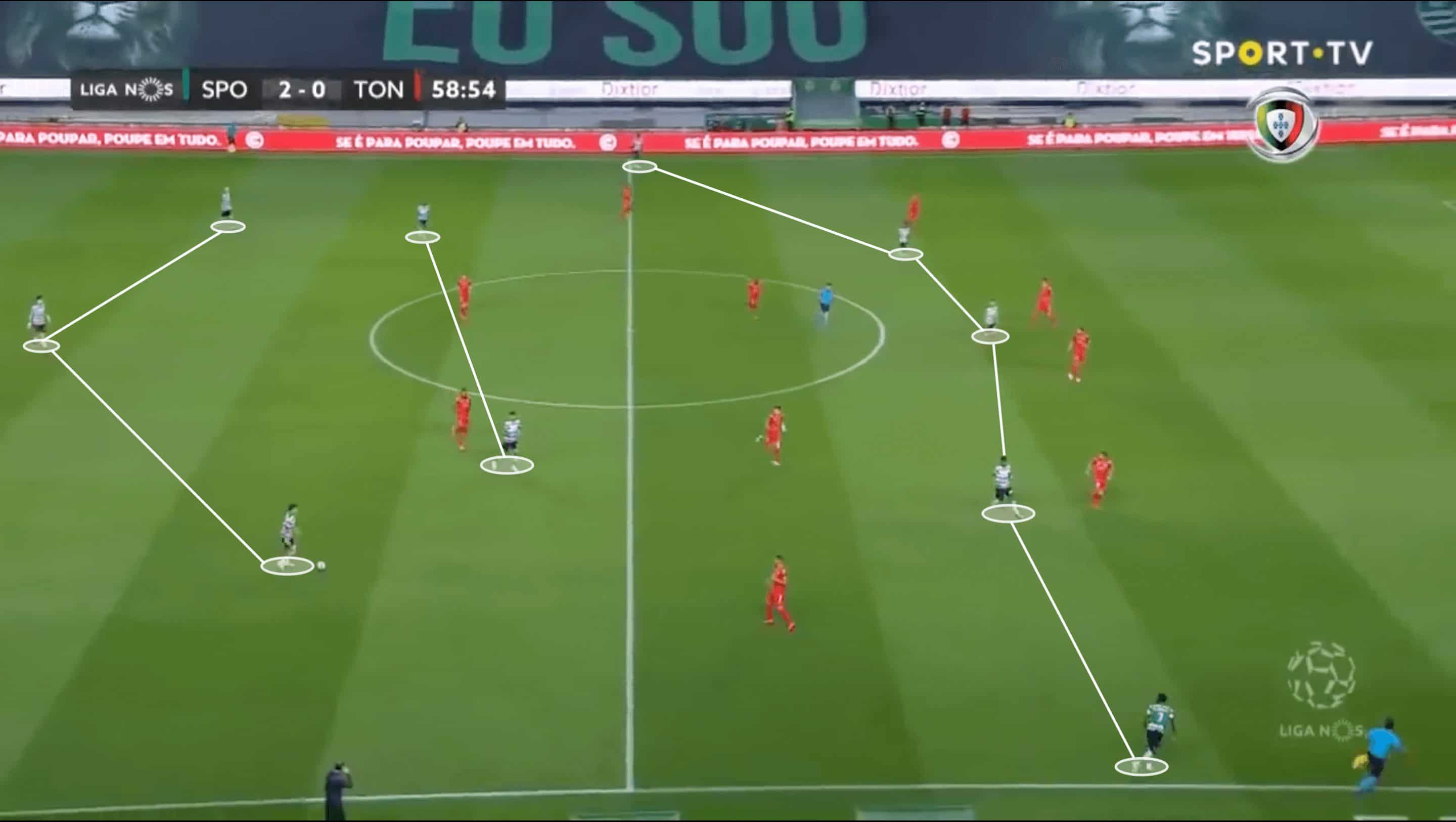
With the change of formation to a three at the back, and the injury to former Barcelona man Jeremy Mathieu, Sporting desperately needed a quality centre-back that had good ball-playing abilities and could assume the role of the “build-up starter”. On the left side, Marcus Acuña is an almost perfect fit for the wing-back position, however, the Argentine is not the quickest and exploding into space is not his best trait, plus he needed some real competition for his spot on the team.
A bit further up the pitch, neither Idrissa Doumbia nor Rodrigo Battaglia showed enough qualities to play in the midfield due to their lack of ability to play progressively and find teammates in between the lines, therefore, Sporting needed a strong midfielder, with good passing and defensive abilities, that was able to receive the ball on the half-turn with no fear and find those line-breaking passes to form the midfield duo with Wendel.
Lastly, with the returns of Yannick Bolasie and Jesé Rodriguez to Everton and PSG, Sporting needed wingers that were able to receive the ball in between the lines in the half-spaces, combine with teammates, and also provide explosive runs in behind the defensive line.
Having all this in mind, we will now take a look at the already mentioned players and their impact on the team from a tactical and statistical point of view.
Nuno Mendes
Nuno Mendes is an 18-year-old left-back/left wing-back from the Sporting academy. Before his introduction to the team, the left wing-back spot was occupied by Marcus Acuña, and these are two players with different characteristics. Nuno Mendes is a fast and skilled player who is very capable both attacking and defending, while on the other hand, Acuña is a much more physical player who engages in a lot of duels who also offers good contribution in attack and in defence. With Nuno Mendes playing as a left wing-back, in a system that requires the player in this position to provide width and attacking depth, Sporting gained a more dynamic player who is capable of making explosive runs in behind the defensive line and deliver good crosses or passes to finishing areas.
In the image below we can see Nuno Mendes using his pace and ball carrying abilities to run past FC Porto’s full-back and then play a cross to the near post where Sporar made a run to.
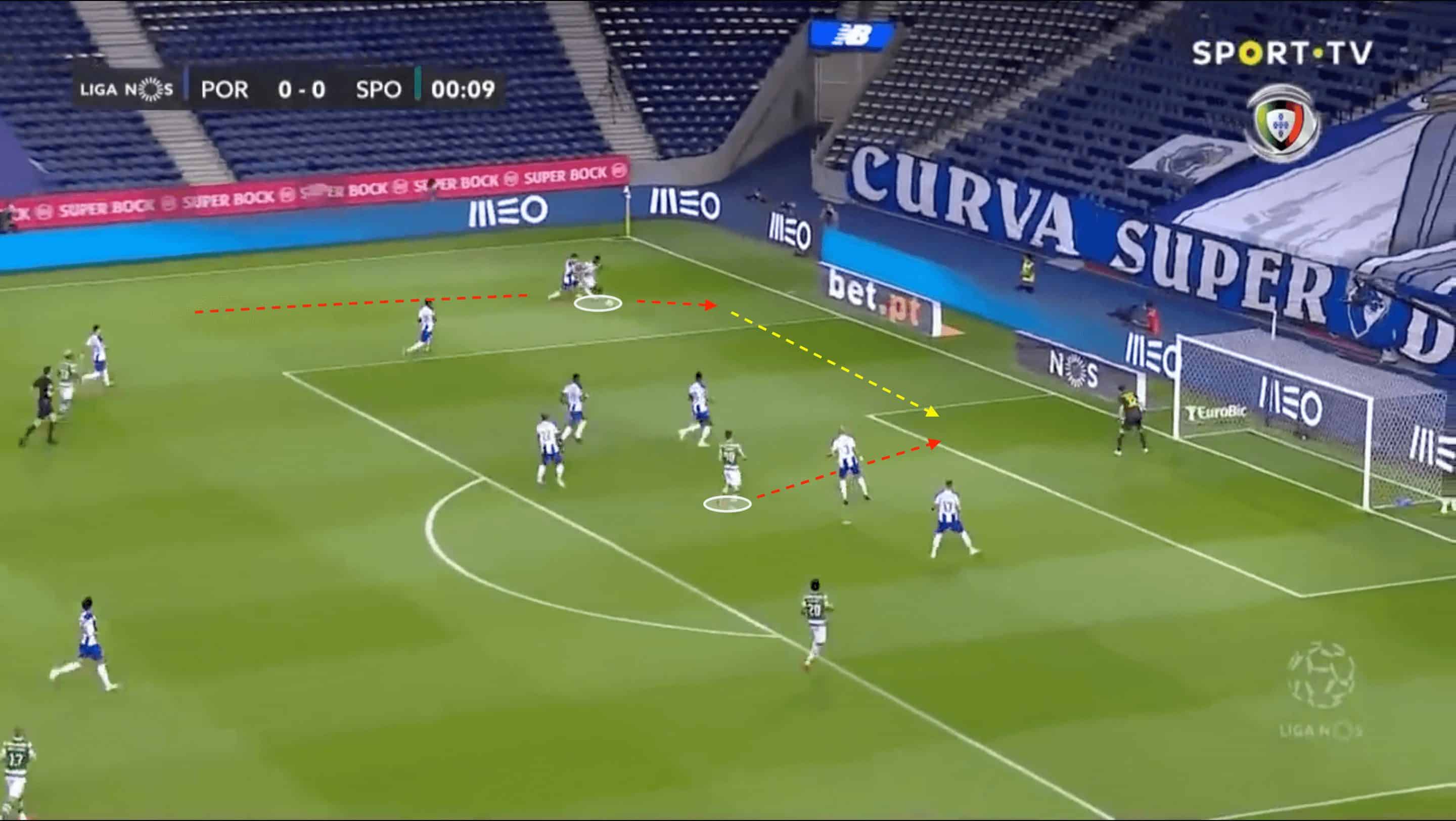
Besides the attacking involvement in the final third, Nuno Mendes contributes massively to Sporting’s build-up play. Despite his age, he is a player that shows great ability to play under pressure, and is able to maintain possession very well. He is a good passer of the ball and reads the game well, allowing Sporting to be able to progress the ball through his side. In fact, progressing the ball whether through passes or with carries is one of Nuno Mendes’s strong points, and we see him driving the team’s attacks forward many times.
Below is a good example of Nuno Mendes’s vision and passing abilities. In order for Sporting to be able to progress in their build-up play, Nuno plays a forward pass into space for Jovane who is making a run from the half-space into the wide areas.
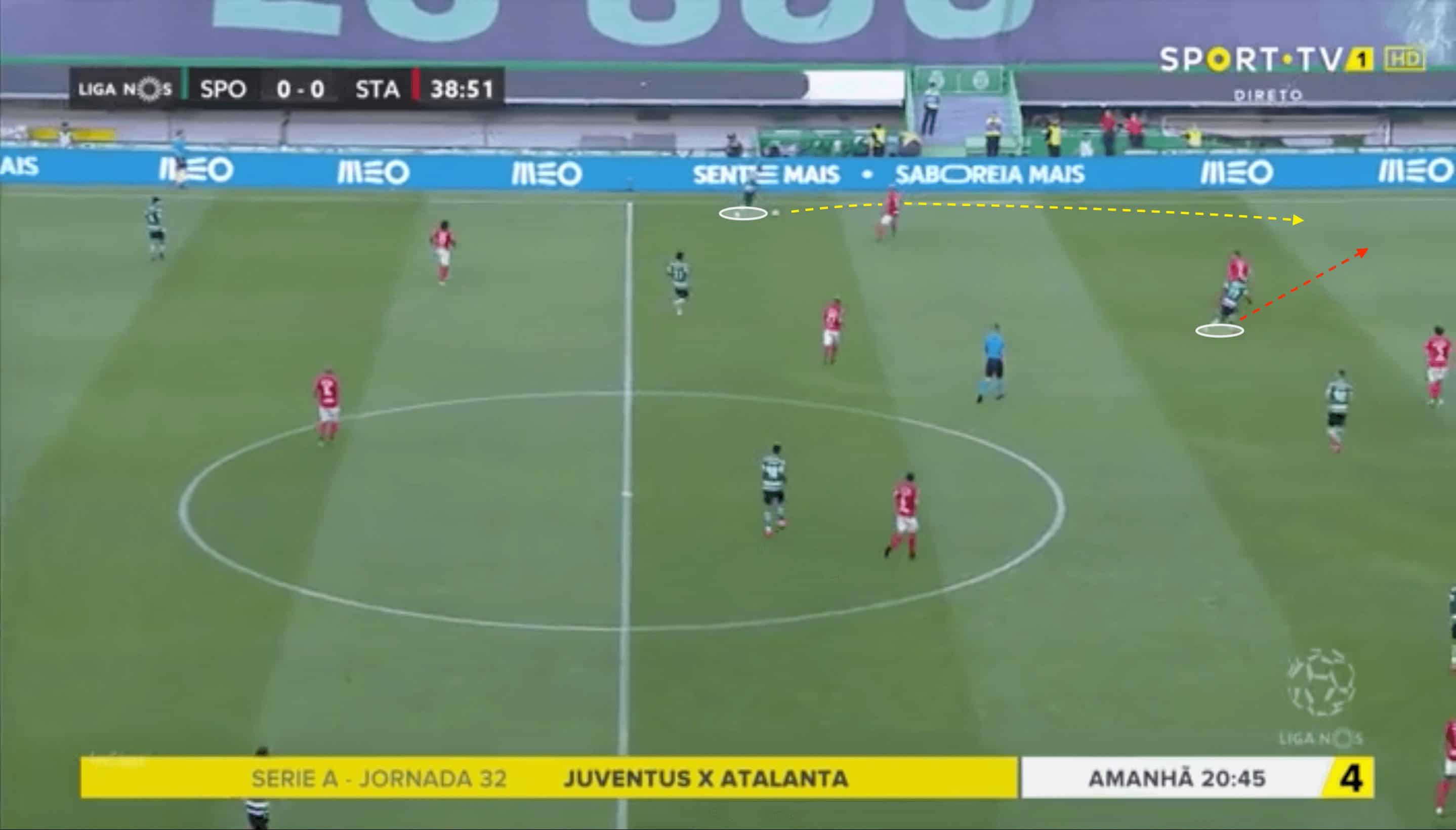
On the defending side of the game, Nuno Mendes doesn’t fall short on the standards set by his attacking contribution. Nuno has good 1vs1 defending abilities and tackling technique which allows him to win a lot of duels during the game. His already mentioned game reading skills enable him to anticipate and intercept many passes, regain possession, and start the attack for Sporting again. His good speed and stamina are a big asset for the defensive transition since Nuno is often in very high positions when attacking.
A good example of Nuno Mendes’ defensive and game reading skills can be seen below, where he spots the pass to the player next to him and is able to anticipate and intercept it.
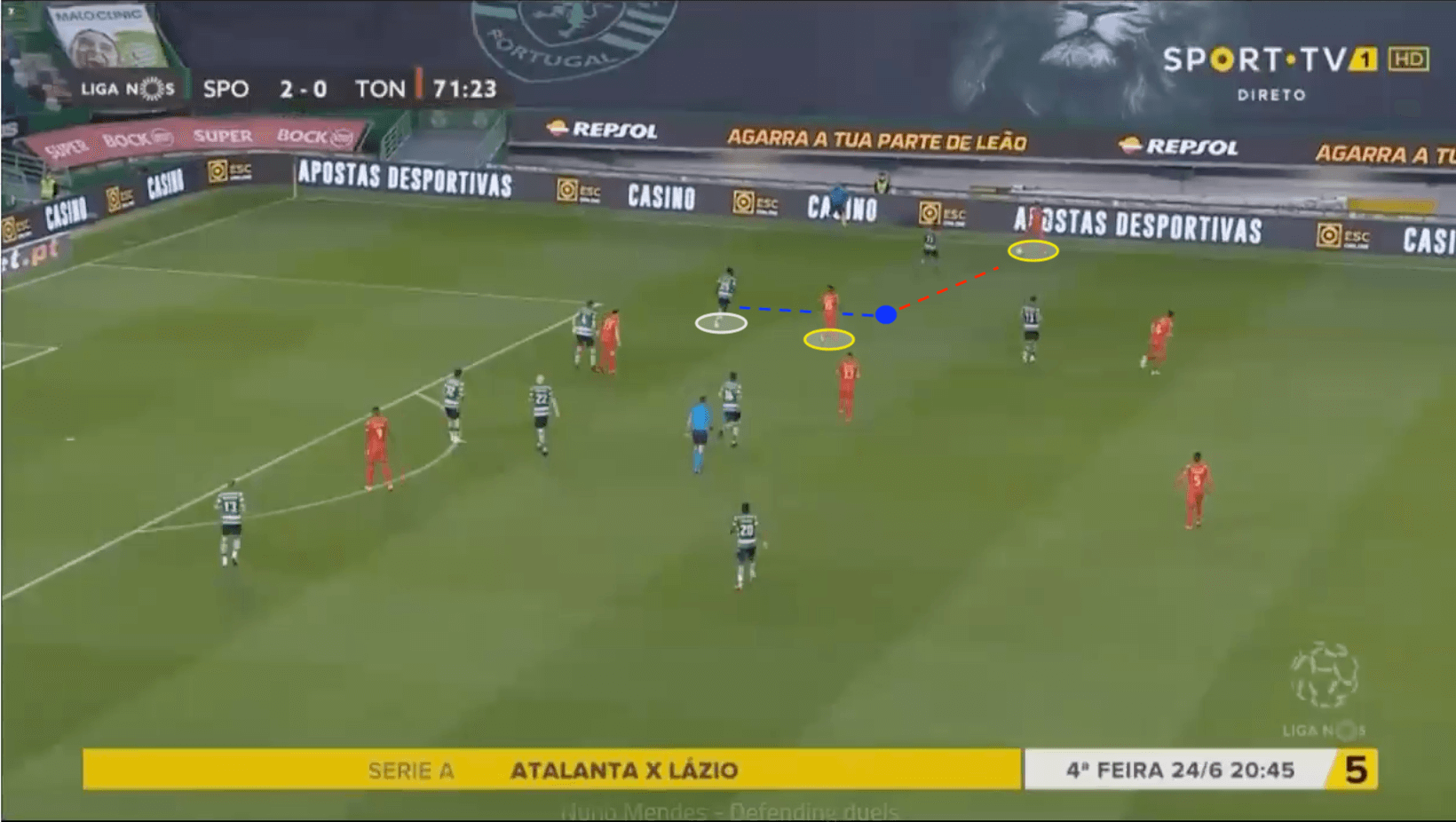
When compared to Marcus Acuña, Nuno Mendes brings Sporting more dynamic and ball progression abilities. The Portuguese youngster looks more lively on the pitch and is always ready to make runs and take advantage of his speed. He doesn’t fall much below Acuña’s passing and abilities and is able to defend without recurring a lot to physical duels, using his reading of the game and anticipation skills instead. This different approach to defending is a smarter one that results in fewer fouls and proves to be very effective.
Take a look at Nuno Mendes’s data profile, it includes his percentile ranks when compared to his teammates in key metrics, as well as his heat map for this season which highlight the areas of the pitch he occupies the most.
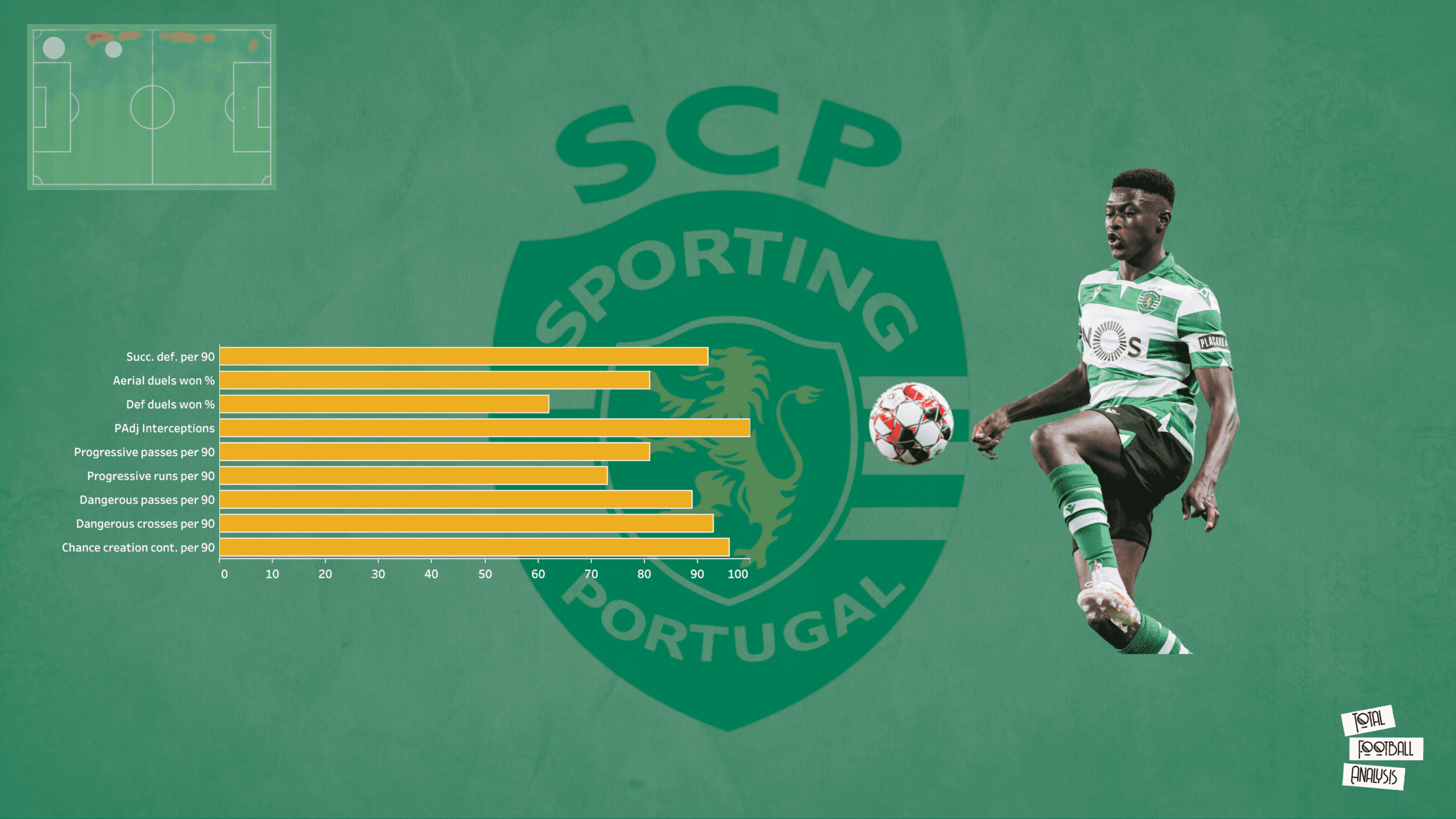
Eduardo Quaresma
Another product of Sporting’s academy, Eduardo Quaresma came in to play in a very crucial spot on the team at only 18 years old. Because of Sporting’s system and tactics, the centre-backs play a big role on the team’s build-up play, they are the ones that start the attack, try to force the opposition to press, and then find a line-breaking pass to progress the ball into more advanced areas. Doing all this, while also needing to provide the defending aspect of the game, could seem a bit overwhelming for the youngster at first glance, Eduardo, however, came into the team and proved to be just the player Sporting needed with the retirement of Jeremy Mathieu and the lack of other good options. Sporting have only conceded 6 goals in the 6 matches he played at the time of writing, and despite it not being a solo effort, Eduardo played an important part in the team’s defensive solidity.
Physicality is not one of Eduardo’s main characteristics when compared to other centre-back options Sporting have like Luís Neto or Tiago Illori, however, his intelligence, game reading skills, and ball-playing abilities are much better than the others. Eduardo Quaresma relies on his concentration and reading of the game to be able to intercept passes and track runners, with decent speed, he is more often than not able to sop the opposition’s attacking plays. When it comes to tackling and duels, he is a huge improvement when compared to any of the other options Sporting have for that position. Quaresma is impressive at timing his tackles and approaching the opponent, he is patient enough to wait for the right time to engage and shows high levels of technique when tackling.
In the image below we can see a lot of Eduardo Quaresma’s defending abilities coming into play. A ball is played over the top of Sporting’s defensive line and, with Coates (4) out of position, Eduardo Quaresma makes a crucial interception. Reading the intention and direction of the pass well, and having the right body orientation, the youngster is able to get to the ball first than Vitória SC’s attacker and prevent any danger for his team.
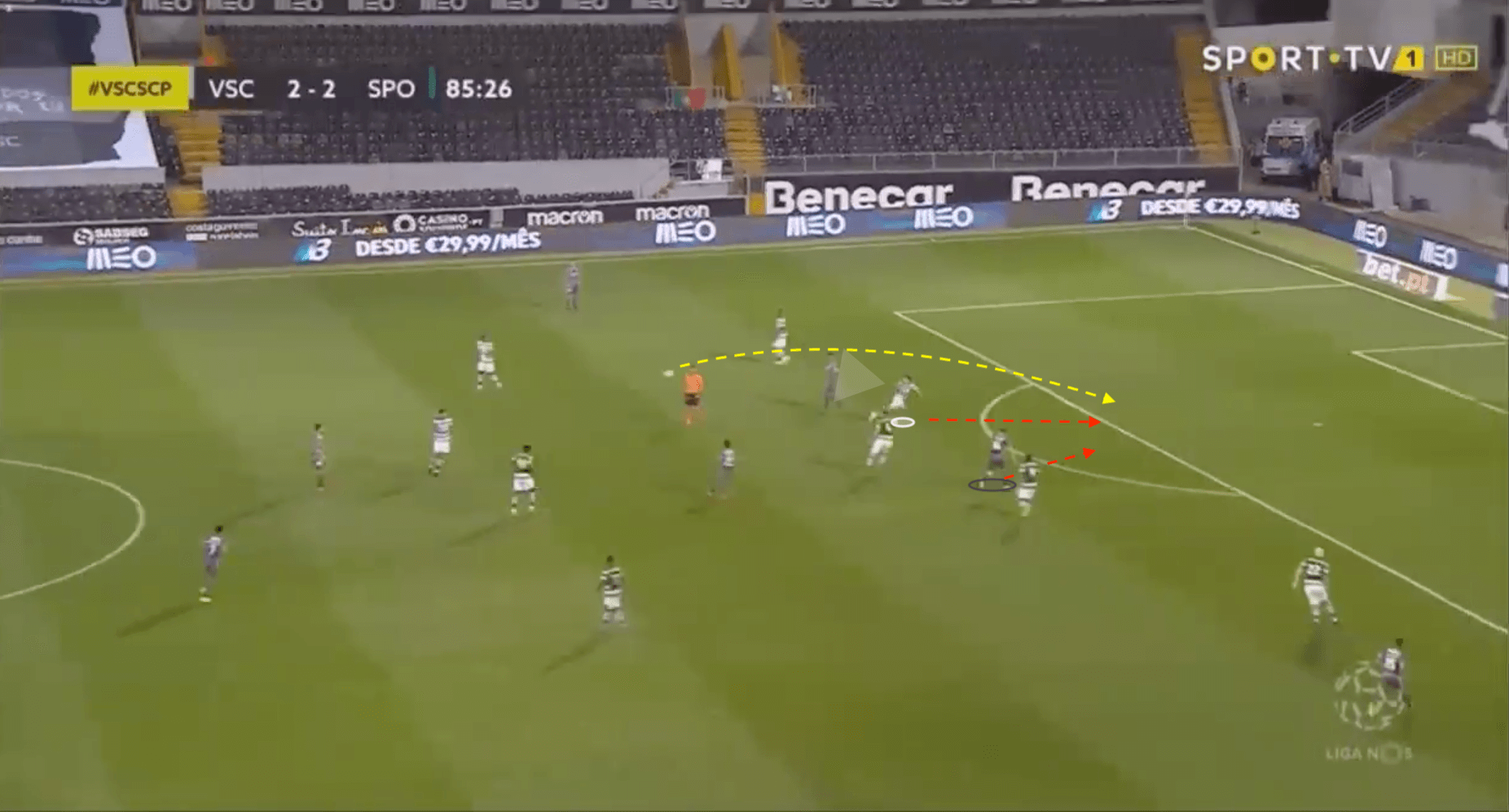
Like it was already mentioned, Quaresma has very good ball-playing abilities and is, again, a huge improvement in that chapter. With the youngster playing at centre-back and starting the build-up for Sporting, the team is able to progress up the pitch and keep the ball much better. Because of Eduardo’s passing skills, Sporting now has a player able to find teammates in between the lines consistently, as well as someone who feels comfortable on the ball and doesn’t panic when pressed. He still has a lot to grow and might make an odd mistake here and there, however, Quaresma as proven to be excellent at building the play from the back for Sporting.
Below is an example of Eduardo Quaresma playing a line-breaking pass to Jovane Cabral who is occupying the space in between the lines.
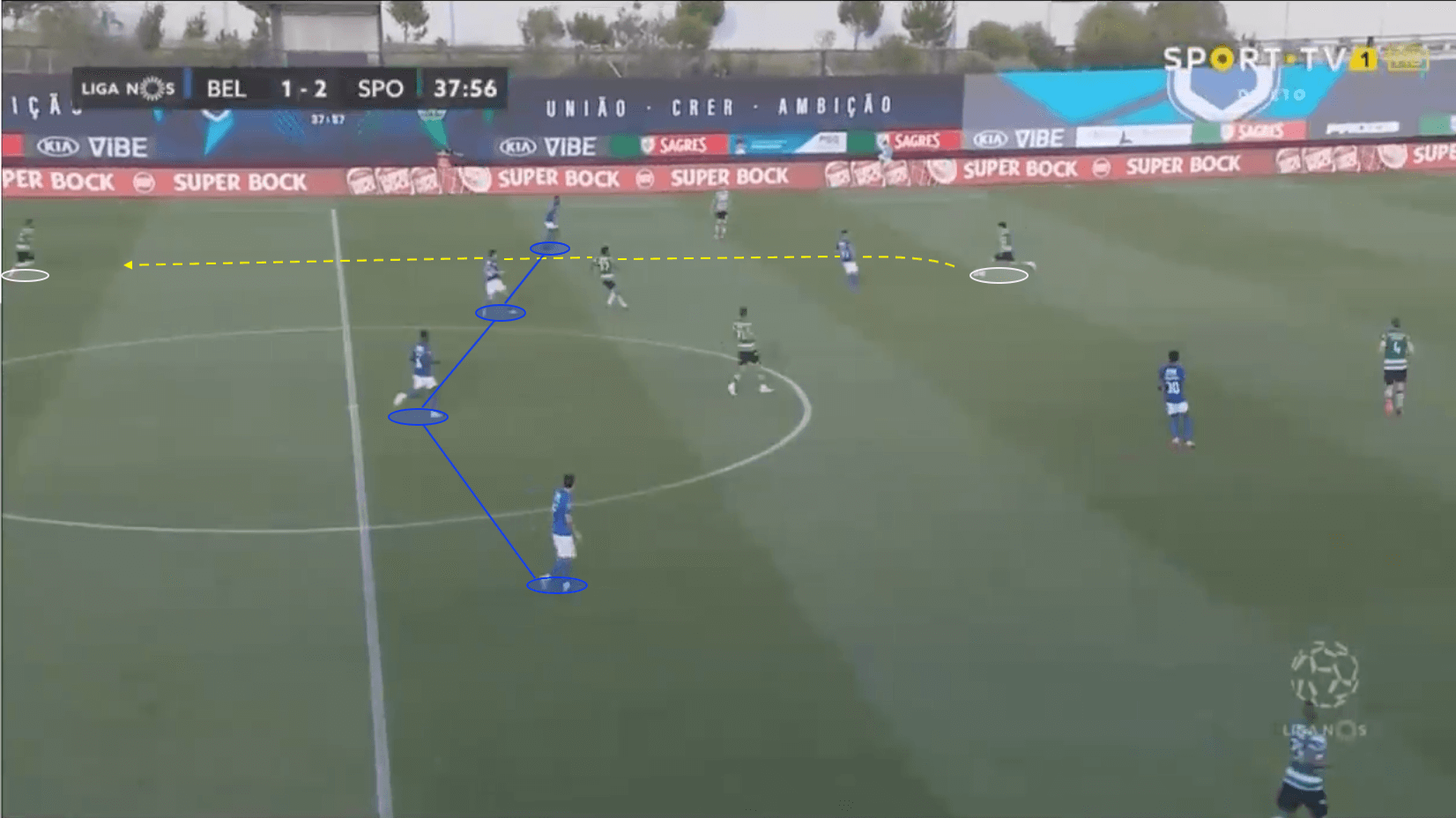
Take a look at Eduardo Quaresma’s data profile, it includes his percentile ranks when compared to his teammates in key metrics as well as his heat map for this season which highlight the areas of the pitch he occupies the most.

Matheus Nunes
Matheus Nunes is a 21-year-old Brazilian midfielder that can fulfil different roles around the midfield. Before his introduction to the team, the more defensive place in Sporting’s midfield beside Wendel was occupied either by Idrissa Doumbia or Rodrigo Battaglia, but both of them showed some limitations in key areas. Matheus came into the team and brought what neither of those two players could, the ability to play progressively and the courage to receive the ball on the half-turn and face the game. Out of all the youngsters introduced to the team, Matheus Nunes is the one that might fall more under the radar and that took more games to get used to playing in a higher level, however, the Brazilian is now a regular for Sporting playing in the midfield.
Like a lot of Brazilian players, Matheus Nunes shows good technique and that translates into good passing abilities, first touch, and dribbling skills. His good passing technique, and passing range, make him perfect for the midfield spot next to Wendel. The other Brazilian is a more attacking-minded player who likes to occupy more advanced areas of the pitch, Matheus on the other hand, often acts more of a supporting midfielder giving his teammates passing lanes and switching the play from one side to the other. When compared to Idrissa Doumbia and Rodrigo Battaglia, Matheus is much more comfortable on the ball, he is able to resist to press a lot better than those two players and is most definitely a better passer of the ball.
Below we can see Matheus Nunes switching the play to the far side where Nuno Mendes is in a 1vs1 situation (out of picture)
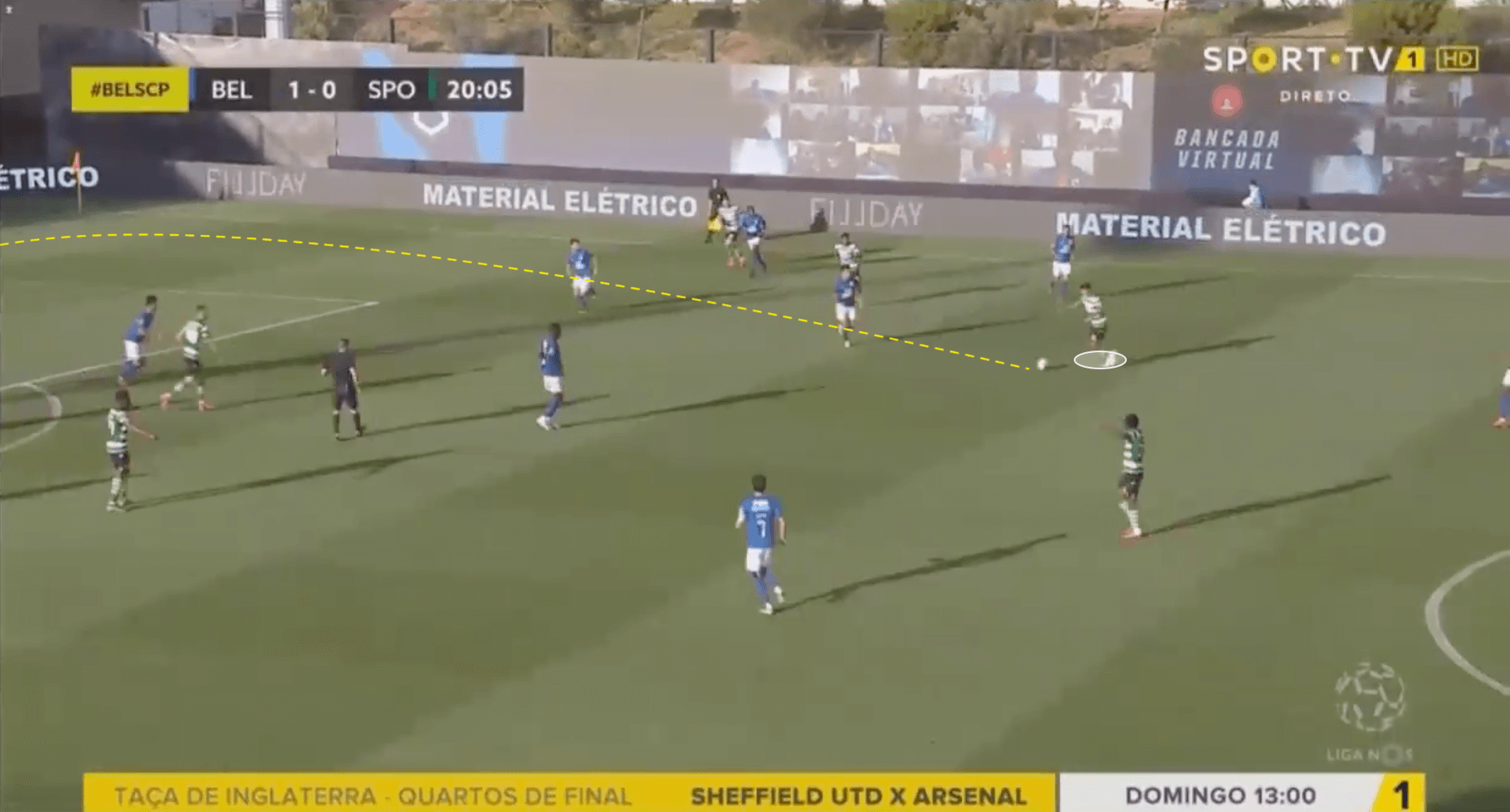
The biggest difference, and the one with most impact in the team’s performances, between Matheus and the other midfield options Sporting has, is the Brazilian’s ability to play progressively and find teammates in between the lines. Matheus Nunes scans the pitch several times during the game and that allows him to know what’s around him and to be able to recognise space better, in other words, to have better spatial awareness. This way, the Brazilian is able to direct his first touch according to the pressure and space he previously recognised, that allows him to face the game more often and, as a consequence, he is able to play line breaking and progressive passes. With Matheus Nunes and Wendel on the pitch Sporting now have not one, but two players able to link up the play between the defensive and final third while also providing defensive support whenever needed.
In the image below we can see Matheus Nunes turning into space so that he can play progressively. Because he scanned his surroundings before receiving the ball, he was able to identify the space that he could turn into.
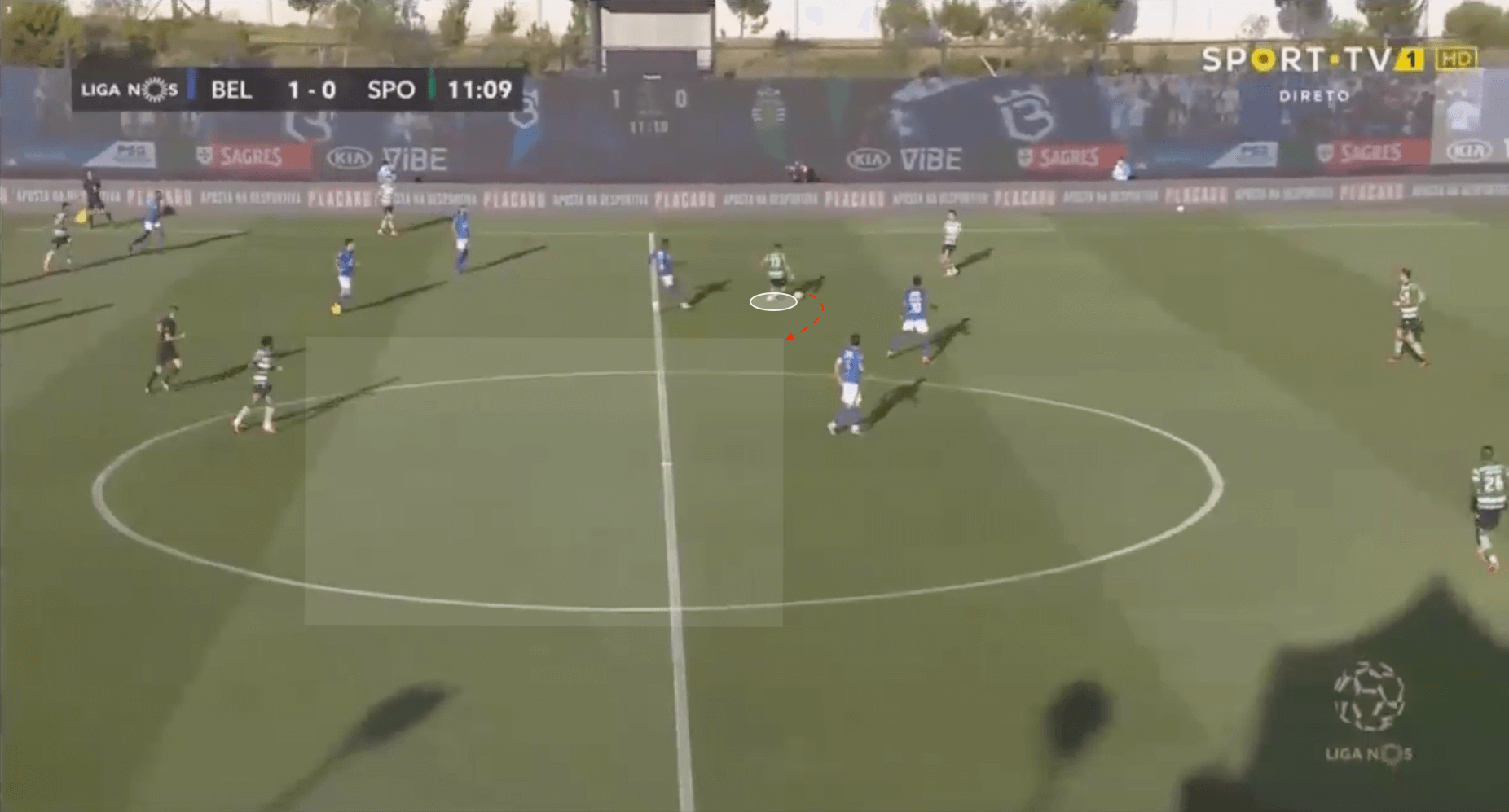
Check Matheus Nunes’s data profile below, it includes his percentile ranks when compared to his teammates in some key metrics, as well as his heat map for this season which highlight the areas of the pitch he occupies the most. Like it was said, he is the one who took more time to get used to a higher level, however, his impact has been noticeable.
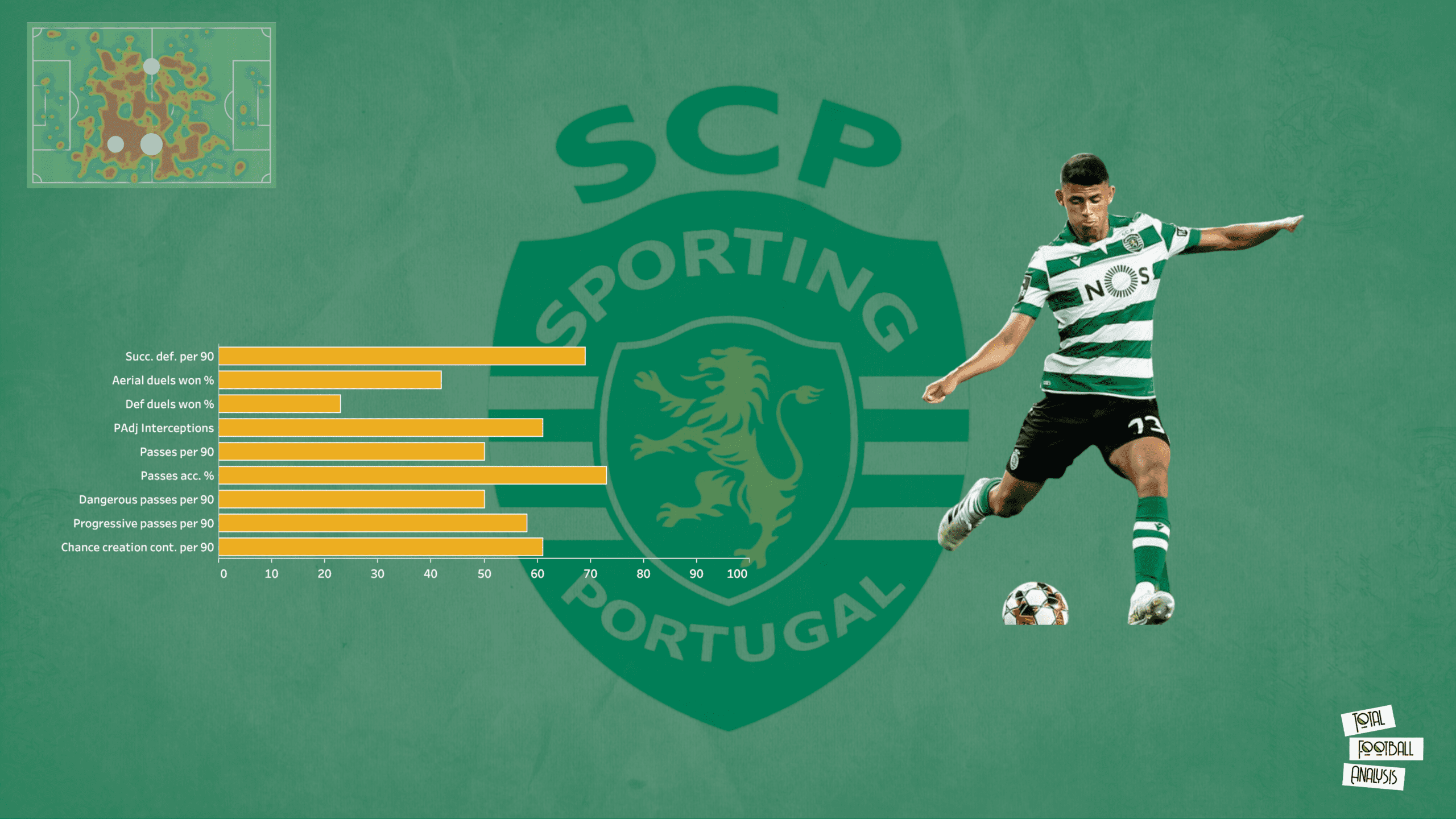
Jovane Cabral
Jovane Cabral was already a part of the first team but wasn’t getting much game time before Rúben Amorim was appointed as head coach, however, the 22-year-old winger from Cabo Verde made a huge impact when he started playing under the new coach. Since the restart of the league Jovane Cabral is the team’s best scorer with 5 goals and also provided 1 assist. The youngster is performing at a good level and, with the departures of both Yannick Bolasie and Jesé Rodriguez, this evolution from Jovane was very important for Sporting as they needed someone to play on the wings. Jovane’s profile fits perfectly in relation to his role on the team, he is a fast and physically strong player who likes to take on opponents and has a very strong shot. Playing as an inverted winger, he uses his physique to be able to receive the ball in between the lines even when under pressure from opponents. He is also able to turn and face the opposition’s goal with some ease and, because of his creativity, he can pose a real threat to defenders as they don’t know if he is going to dribble, pass, or take a shot at goal.
This next image is a good example of how Jovane is able to receive the ball and immediately turn and accelerate towards goal. Because of his speed and acceleration, he has a big advantage over his opponents and is often able to attack space with success using his first touch.
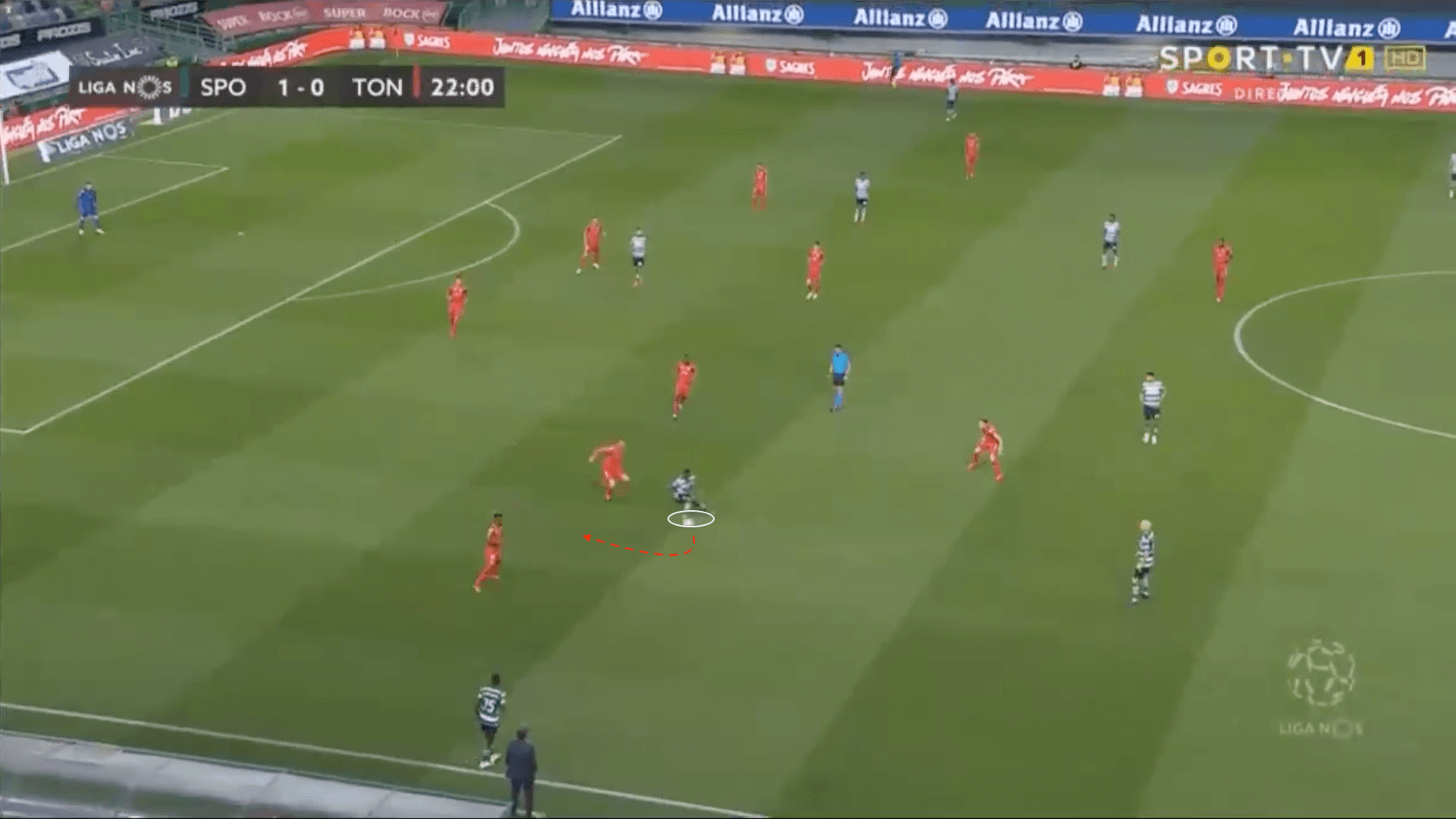
Once he gets into good positions, Jovane has a tendency to try and shoot if he as a good angle. Despite some overhit and wide shots, Cabral has scored some amazing goals from distance. He likes to cut inside onto his right foot and try to find the top corner, he is also very dangerous when it comes to direct free kicks. Because of his speed and shift of direction, he is often able to find the space he needs to shoot, and if he hits the ball well, his shots are very dangerous. Jovane has also shown good indicators as far as is selfishness is concerned, he is now a player that has a better notion of when he shouldn’t hold on to the ball and tries many more combinations with his teammates.
This next image shows us a typical movement from Jovane Cabral, playing on the left side, he cuts inside and tries to find space to shoot. He has a very powerful and dangerous shot, and has been able to score and create a lot of danger through this type of action.
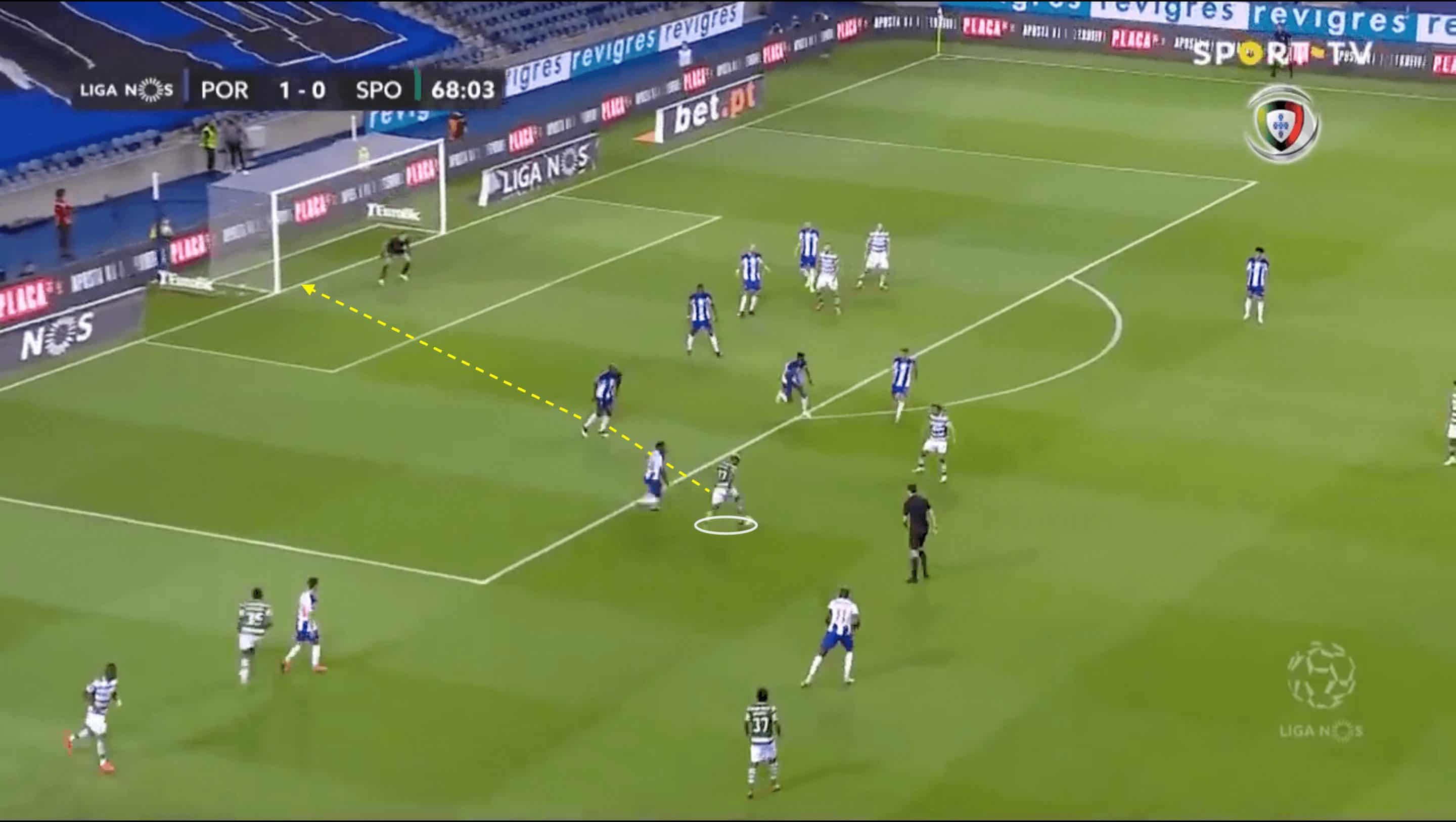
Finally, below we have Jovane Cabral’s data profile, it includes his percentile ranks when compared to his teammates in key metrics as well as his heat map for this season which highlight the areas of the pitch he occupies the most.
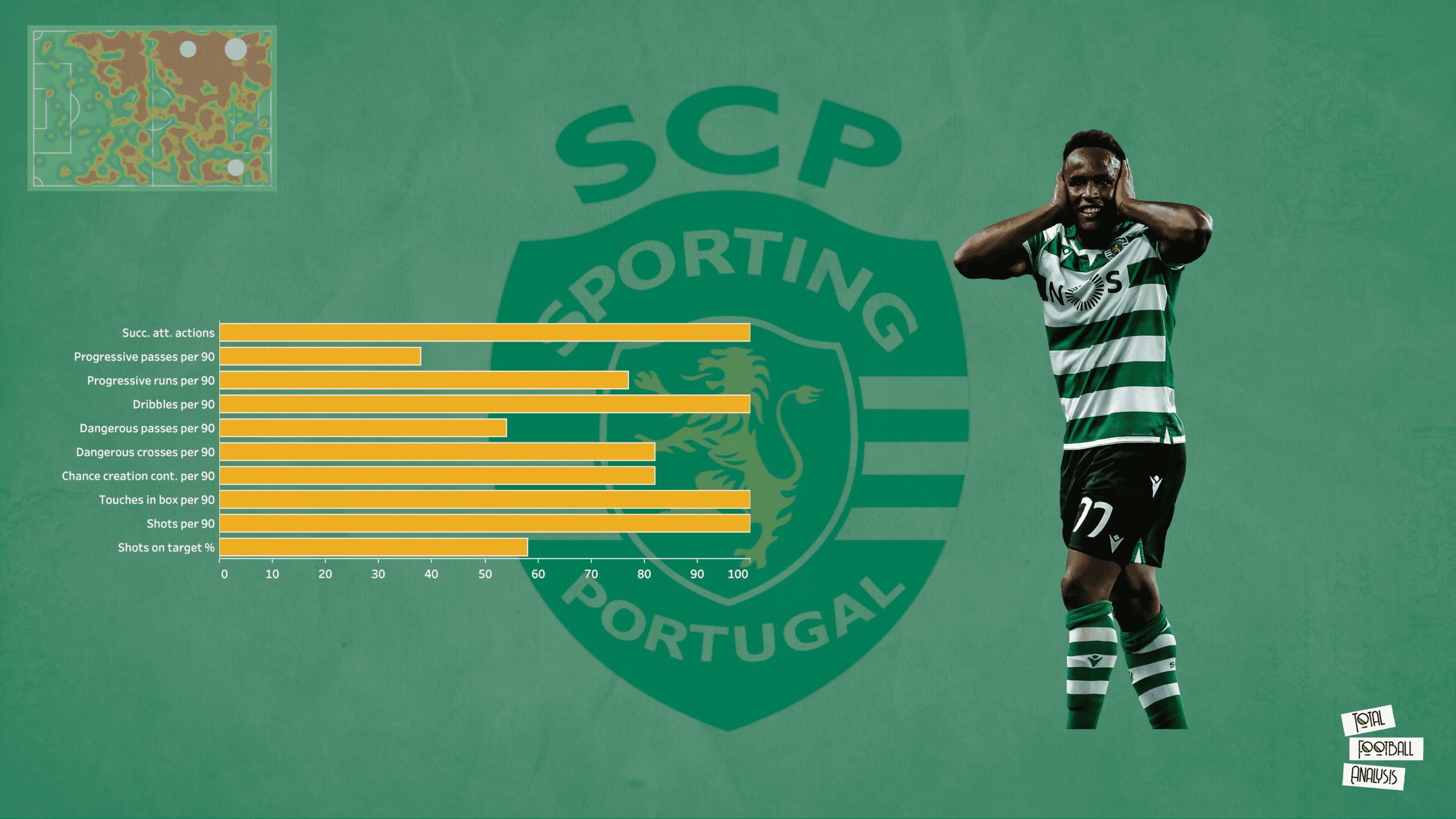
Gonzalo Plata
Much like Jovane Cabral, Gonzalo Plata was already a part of the first team but was only starting to play his first minutes. With the arrival of Rúben Amorim, Plata grabbed the right winger position and started to be a regular first choice. The Ecuadorian is a fast and skilled player with a very good left foot. Playing as an inverted winger he occupies the half-space most times when the team is in the build-up phase and he has a natural tendency to drift inside onto to his left foot. Despite that natural tendency Plata is not as direct as Jovane and doesn’t go for goal straight away, instead, he prefers to either try and combine with his teammates to receive the ball inside the area, or dribble his way into it, to then provide an assist or try to score. His good ball control also allows him to receive the ball in the half-spaces and in between the lines comfortably which is something very important for Sporting’s build-up play.
In the image below we can see Plata dropping deep to receive the ball in central areas and playing a through pass to Wendel who got into a 1vs1 situation against the goalkeeper.
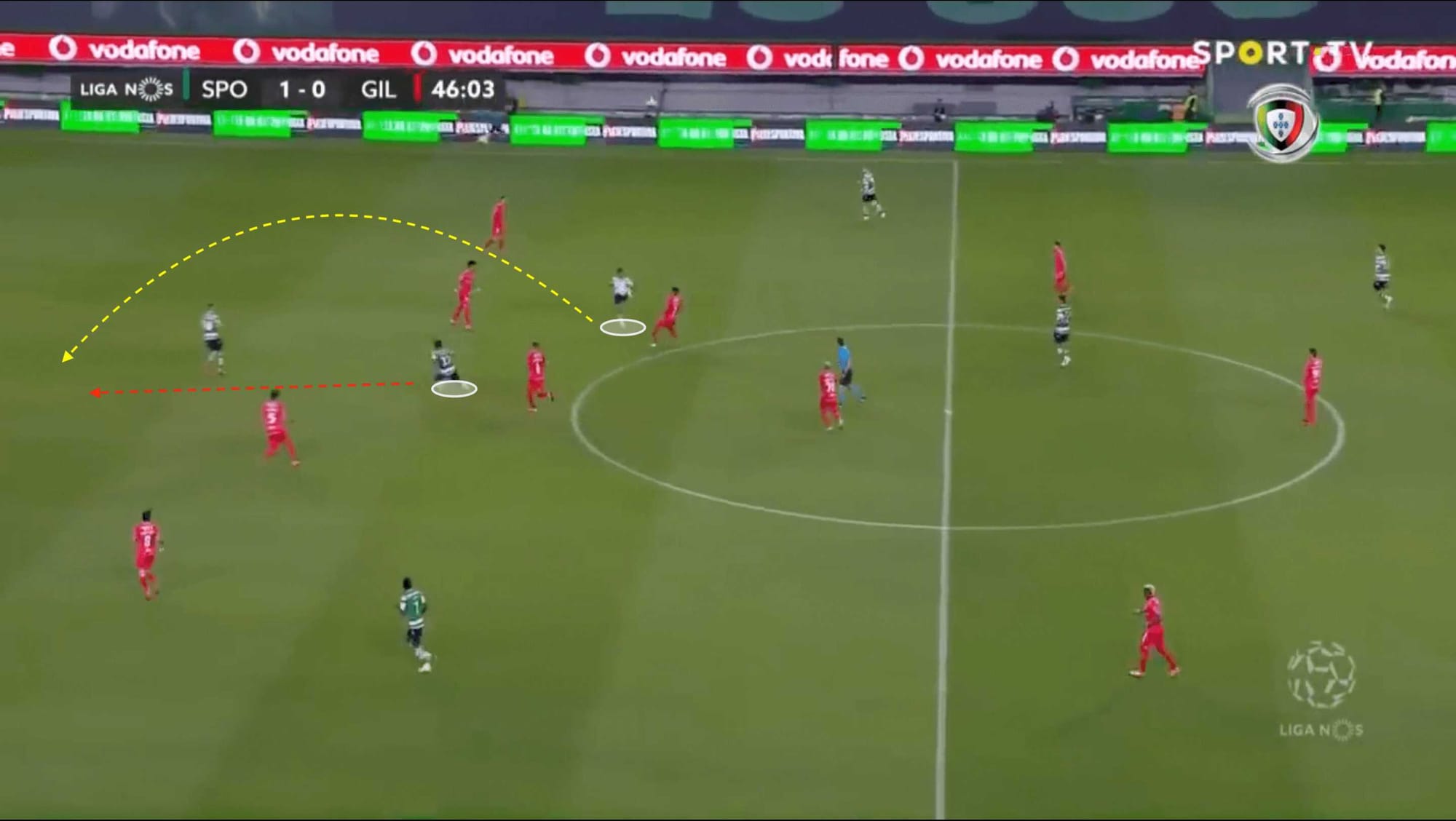
Plata has proven to be a very dedicated player with an impressive work rate, in fact, he has surprisingly good tackling and ball stealing abilities. Gonzalo is also an important piece when it comes to Sporting’s press, the youngster is very smart in the way he presses opponents and is able to get the ball from them in advanced areas, creating opportunities for his team.
This next image shows an example of Plata reacting quickly and, because of his good positioning for pressing, he is able to intercept the pass and score.
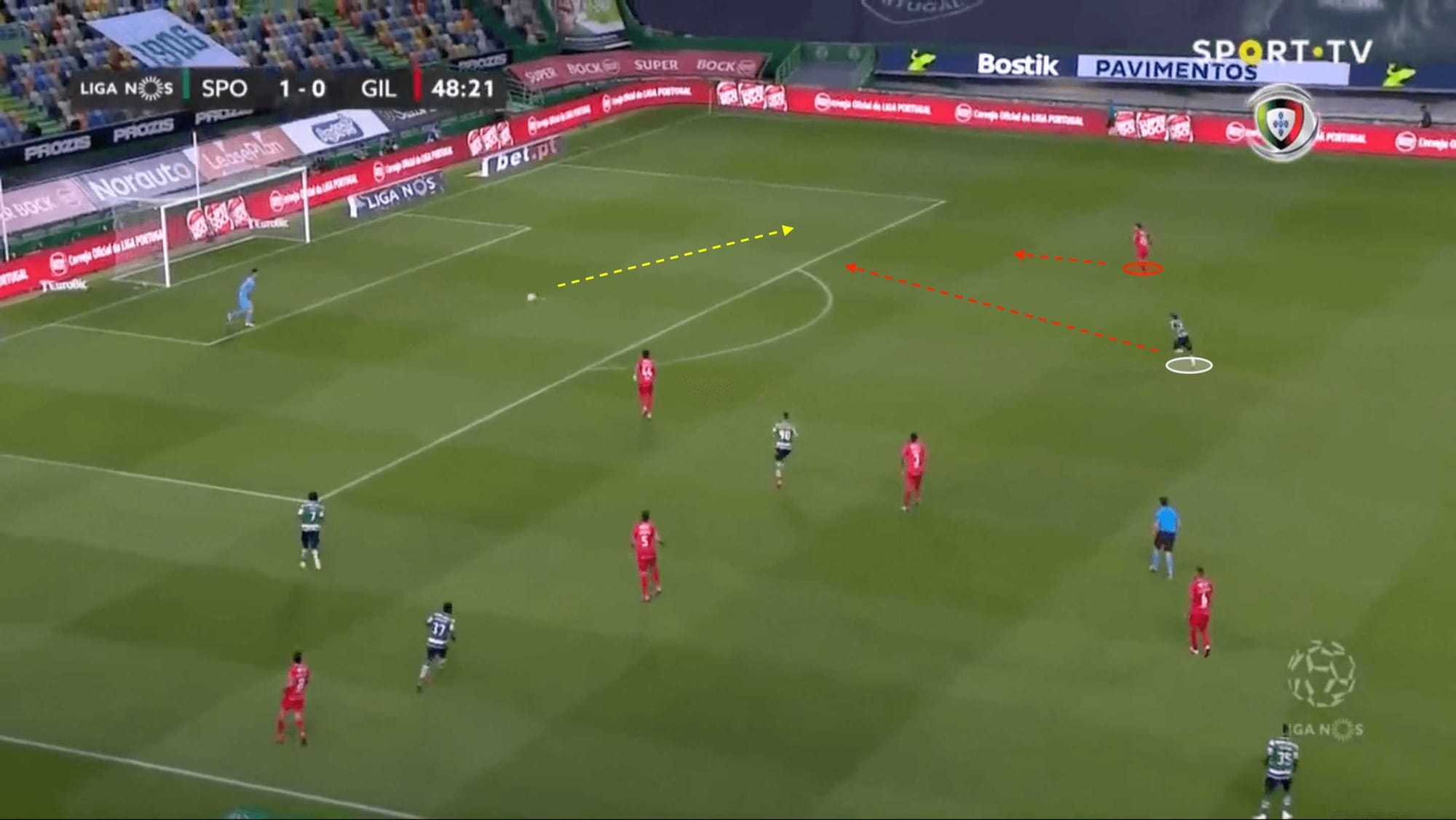
Another key attribute of the Ecuadorian winger is his ability to take on opponents on 1vs1 situations, for that, he makes very good use of his pace and acceleration but there is also a big element of creativity and unpredictability to his play. His physical constitution doesn’t resemble one of an agile player, however, Plata is able to move with great coordination and speed in tight spaces and his often seen gliding past opponents. Of course, like any other 19-year-old, he still has to improve in many aspects such as his decision making, however, the amount of minutes he has been playing has already contributed to his development in that and other aspects. Proof of that is that Plata has scored one and assisted one since the restart of the league and has shown some consistency on his performances.
Here is an example of Gonzalo Plata using his 1vs1 dribbling abilities to get past his direct opponent and get into the penalty area. He gets close to the byline and then makes the pullback for an arriving teammate who scores.
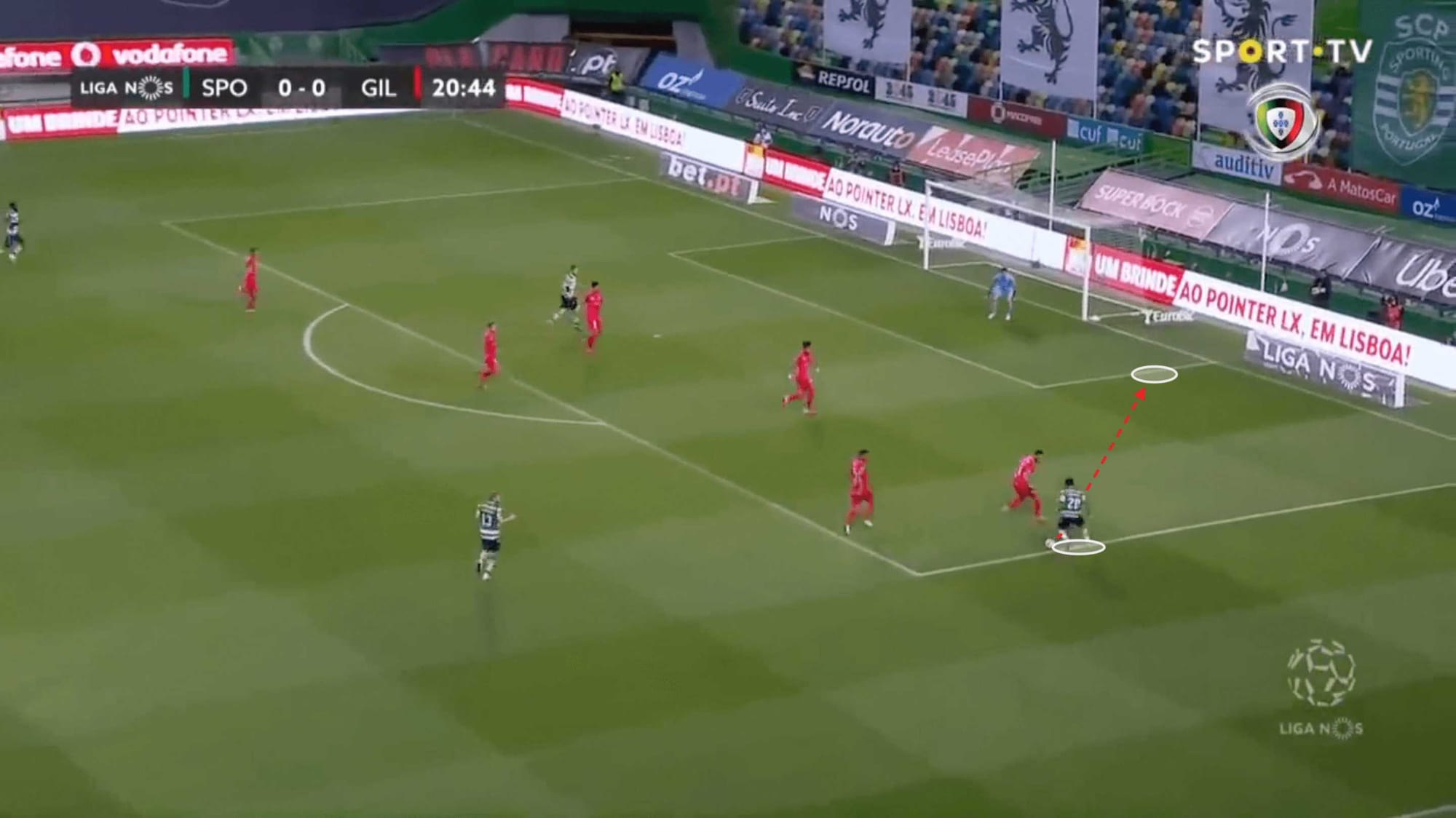
Finally, below we have Gonzalo Plata’s data profile, it includes his percentile ranks when compared to his teammates in key metrics as well as his heat map for this season which highlights the areas of the pitch he occupies the most.
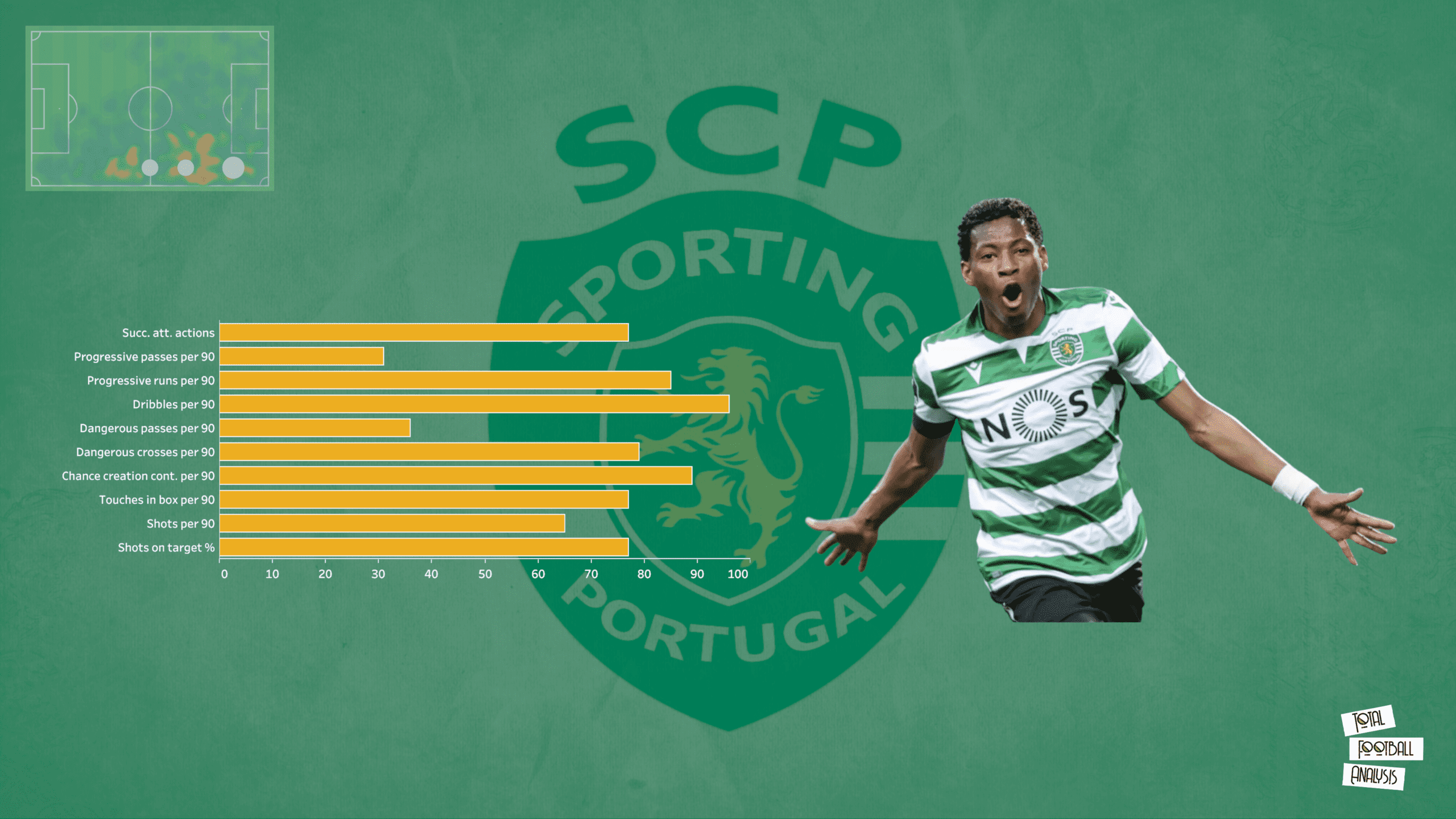
Conclusion
This article has shown how five youngsters were able to bring a new life to Sporting CP’s team and successfully provided for the team’s needs in key positions. The work of Rúben Amorim with these young players has been formidable, he gave them the opportunity to play in the first team, along with the right preparation, and the players have responded brilliantly showing great confidence and taking full responsibility for their duties on the pitch.
The tactical analysis and the data analysis made allowed us to have a better notion of how the players improved the team and to measure the impact they had through some key metrics, but there is still room for these kids to grow.
This season is basically over, but Sporting should have hope and faith on these academy graduates to help the team get back to the glory days in the league and at least finish in a Champions League spot.

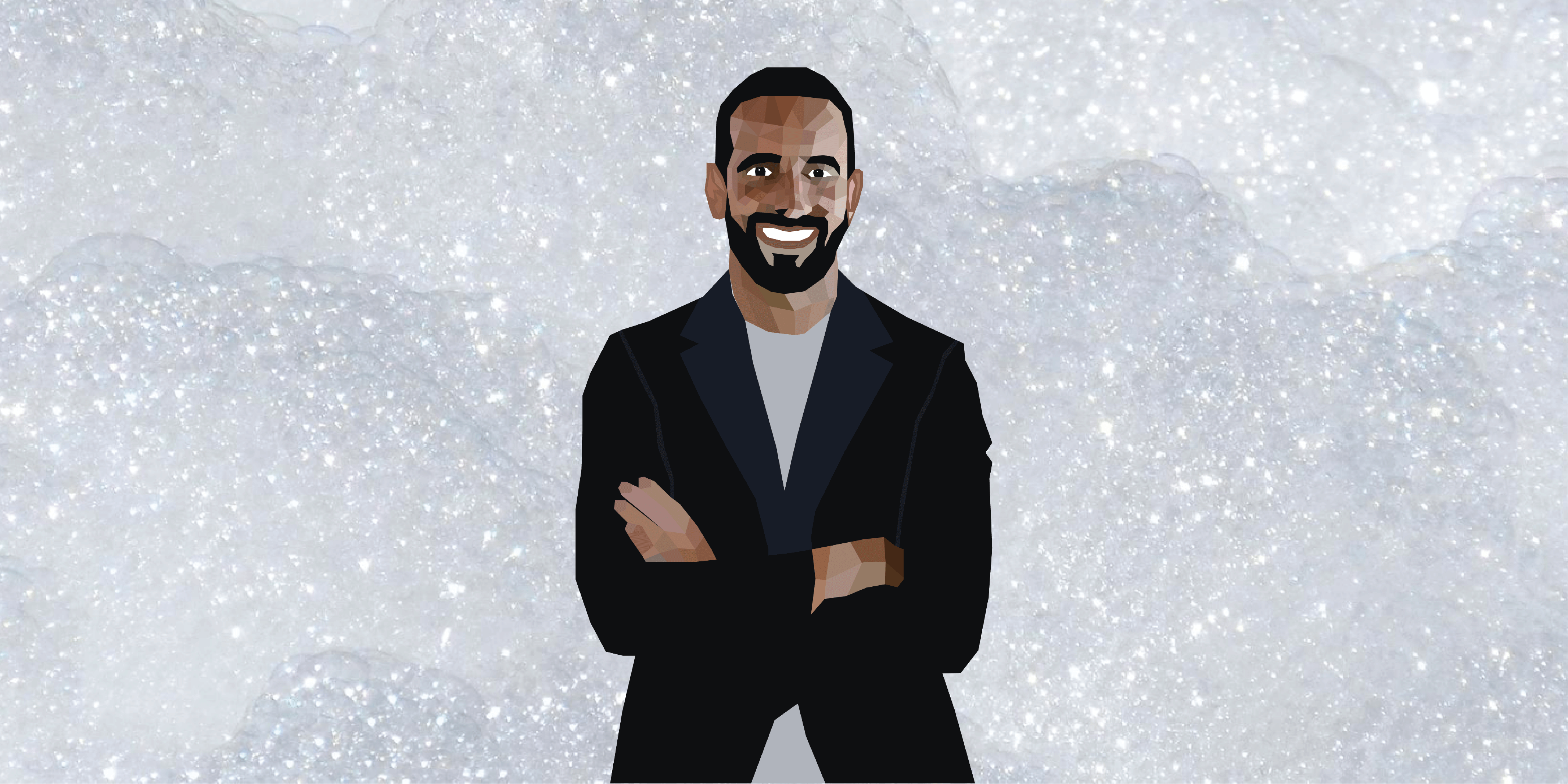



Comments